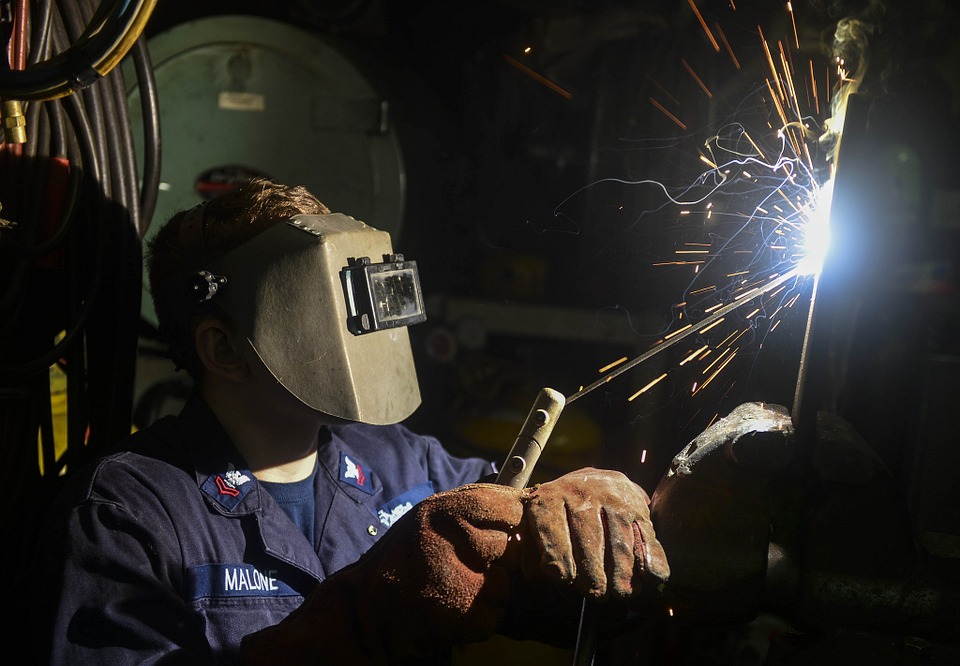It would seem easy enough to set up and operate a welding education program. Identify the things a beginning welder should have knowledge of, organize and teach a course of study, then test students to confirm they have taken it all in.
This basic approached worked well back when welding consisted of only a couple of different processes. However, welding today has become a high-end technology industry. Welding operators now need to develop a broader knowledge base that reaches beyond basic skills and techniques.
In addition, the industry has significant growing needs. The skills gap in U.S. manufacturing 2015 and beyond, a 2014 study by Deloitte and the Manufacturing Institute, projects a large shortage of skilled workers in manufacturing over he next decade. According to the U.S. Bureau of Labor Statistics data, about 2.7 million baby boomers now working in manufacturing will retire over that time, and another 700,000 openings will be created by economic expansion.
This is good news, except that 2 million of those 3.4 million open positions — many of which require knowledge and skills related to welding — are likely to remain unfilled because of the skills gap. But, what skills are exactly missing?
Seventy percent of the executives surveyed for the Deloitte/Manufacturing Institute study said their current manufacturing employees lack necessary technical and computer skills. Additional shortfalls include problem solving skills (69%), basic technical training (67%) and math skills (60%).
As the supply of well-qualified workers decreases and demand for their services increases, the spotlight has been turned to the state of welding education. The time is right to make changes so it does not turn into a hot seat.
The Issue of Supply and Demand
A lot of the current welder training falls under the banner of career and technical education (CTE), a component of public education intended to educate the next workforce. This approach develops skills in students, but many fields like welding have become so technical that having hands-on skills is not enough.
The auto industry provides a good visual. As manufacturers have moved to reduce vehicle weight to meet government-mandated fuel efficiency goals, they also have turned to lighter-but-stronger materials, such as aluminum, magnesium and various high-strength steels. Cutting and welding these materials is harder to begin with; their thinness only adds to that difficulty.
Welding equipment manufacturers have development numerous new technologies that enable auto manufacturers to maintain and increase their efficiency and productivity to help meet these challenges, even as more exotic materials continue to find their way into automotive designs.
As the equipment part of these technologies has grown more sophisticated, it has also led to greater specialization in welding. Additionally, that requires more sophisticated welding operators.
For instance, to produce an arc specifically tailored to a specific task, the welding process, consumables and behavior of the power source have been fine tuned and research is conducted to find the proper shielding gases. That is then brought together to address manufacturers’ increasingly delicate, nuanced and subtle needs. However, the operator overseeing the new welding technologies is a key part of achieving success. This means the knowledge required of these operators continues to grow.
Pipe welding and havy fabrication operators face a similar situation. Today, these operators often direct the welding process using a pendant controller or even a robot. They must have appropriate, intense knowledge to operate or even the program the robot in order to do this — one that reaches beyond basic welding skills.
This is because operators now control so many things about the arc, and do so many things with it, they now need to know more about how to set up the weld, when to leave things alone and when to make adjustments.
Simply put, the act of welding is similar to driving a car with a manual transmission. When you are driving, your brain doesn’t tell you to switch gears, you just start shifting gears. Through repetition, your mind and body work seamlessly, so once you have learned it, you just know how to do it.
A master welder will manage an arc and weld just as if he or she was driving a vehicle with a manual transmission. However, with automation, the robot performs the weld. The welding operator has to understand the arc and everything that is going on with it. “How do I manipulate that pool to make it to stay there? What process should I use? What mode of metal transfer should I use? What tools should I use to control heat input, melt-through, or enhance quality?” Additionally, the welder has to understand basic geometry and other issues. There are so many critical settings and considerations that go into controlling the process where automation, and advanced welding is involved, that it is just not as simple as saying to the master welder, “Let’s put down a weld.”
It turns out that industry’s complaints of not being able to find enough qualified workers to fill vacant positions have less to do with missing skills than with a lack of knowledge. How did we get into this situation? And more importantly, how do we get out of it?
Embracing ‘Ready-Now’ Specialization
Technology has made a difference, changing old roles and creating new ones in welding and many other fields. This also has changed training and education needs for skilled workers.
For example, with farming the training once was generational. Relatives would train future farmers in all they needed to know. However, by the 1960s, agriculture had changed. Instead of requiring a general farming knowledge, the farming industry needed educated workers who could apply the science behind the agriculture.
Further advances led to specialized fields of study and employment. Scan the Ag programs at Texas A&M — agronomy, pant genetics, animal science, meat science, poultry science, agricultural systems and watershed management. By the 1990s, agricultural education once again had evolved to address these additional opportunities and needs.
With the continue emergence of such new frontiers as robotic surgery, technology has changed the medical arena as well, making specialization the norm. Robotic surgery, a minimally invasive technology, still requires a trained surgeon. However, this surgeon needs an advanced knowledge base and skill set that differs vastly from what general surgery requires. Top robotic surgeons often focus on just one or two procedures, but they still rely on an underlying body of medical knowledge.
As the welding industry matures — and it is maturing quickly — the idea of specialization is finally beginning to take hold. Specialization is a new concept in this industry, and it raises the question of whether teaching the same skills that were being taught in the 1990s or early 2000s still meets the needs of industry today.
Beyond that, changes in the business climate in general also have become powerful forces of hiring. The number of technology-related jobs is increasing. The online education news clearinghouse Eudedemic says by 2018 there will be more than 8.5 million jobs in the fields of science, technology, engineering and math (STEM). However, as baby boomers continue to retire, taking with them years of experience-based knowledge as they leave the workforce, two-thirds of companies say they have a shortage of qualified workers.
This will affect companies in 2018 as many will face open positions. According to projections from The Lincoln Electric Co., 617,000 vacant jobs requiring welding skills will need to be filled in this year.
A recent study by the National Federation of Independent Business reported, “Forty-four percent of small businesses looking to hire in July 2015 reported few or no qualified applicants for positions they were trying to fill.” Contributing to that situation is the fact that employers are not searching for beginners with basic skills. They want “ready-now employees” who have the right skills and the right knowledge right now. They want employees who can hit the floor immediately productive and making products.
There is no longer any time set aside for on-the-job training or long-term mentoring programs to get individuals up to speed. Gone are the days when a person can be taught a few welding basics with the expectation of success as he or she grows into the job. The industry today expects anyone who is skilled and trained in this profession to have the right skills and the right knowledge at the right time — when they are hired — to do what is needed.
Do Companies Have an Alternative?
When Bolivar, Ohio-based American Highway Products recently discovered itself struggling to find capable and qualified welders, it turned instead to automation. That allowed this manufacturer of manhole ring-related products to continue its high-quality operation, but it posted a new question: Who would tech the operators about automation?
Here again, the challenge looming before welding educators is to provide additional background knowledge, beyond the basics of welding, to properly equip today’s welding professionals.
The industry’s requirement for ready-now welders with a broader base of knowledge may sound harsh, but it actually points to a wealth of opportunity in welding education. Of course, there always will be a need for entry-level welders. However, beyond that, there is a new emerging growth area in associate’s degree level welding engineering technology that is truly exciting. Unlike the days when, if you told your parents you were going into welding they would picture you working in a dark, dingy, dirty place with a bunch of sparks, welding operators today handle advanced manufacturing technology to produce advanced results.
The occupation offers significant diversity, with tremendous opportunities coming up for welders in a variety of industry segments, including shipbuilding, heavy fabrication and oil and gas. There are also a number of career pathways for welders in production, fabrication, construction and repair. Many are now entering the field as welders can look forward to future opportunities in their employers’ sales, management, information technology or finance departments.
Does this mean everyone in the field is going to need a four-year college degree? Definitely not, but it does lead to an increasing demand for two-year associate degrees coupled with specific certifications. Also, that brings us back to the question of how to best educate future welding professionals.
Three Ideas Going Forward
Adjustments are clearly needed in welding education to make sure industry’s needs are met both now and years to come. One necessary step is to offer more application-specific training. Pipeline companies are searching for one specific skill set, while shipbuilders need skills that are equally specific but different. And in all scenarios, these skills benefit from an expanded base of knowledge.
A second important step is to focus more on STEM education while honing in on particular skills training. To do this effectively, manufacturers and the welding industry must work together to define what skills and knowledge are needed and the develop the curriculum to support these needs. Industry/education/government partnerships such as the RAMTEC program in Ohio, or close advisory relationships such as those used at the 32 Ivy Tech Community College campuses in Indiana, College of Canyons in California and more illustrate the focused efforts of these partnerships. This is a crucial change, given the increased level of sophistication now found throughout welding employment.
Lincoln Electric is supporting this transition by expanding its educational curriculum, both internally and also in what it provides to welding educators. These offerings include a summary list of the skills needed and tools welding educators can use to help develop those skills. It also is sharing its vision of emerging career pathways and plans to help educators train a new workforce equipped to respond to these opportunities.
Beyond that, the company has invested $30 million in a new Welding Technology Center that it is filling with its latest high-tech welding and cutting equipment, curriculum and advanced welding training systems. It is seen as the ultimate train-the-trainer facility and is considered a critical component in raising the level of welding education across the board.
The new Welding Technology Center is anticipated to open late this year, marking the 100-year anniversary of the company’s original welding school, believed to be the longest operating welding school in the world.
Lastly, this also is a good opportunity for the industry overall to take a hard look at how an individual welder’s qualifications are evaluated. Are certifications enough to demonstrate suitability for a specific position? Do credentials alone provide enough information about a welder’s capabilities? Or, what might be a good mix of certificates and credentials? These are difficult questions to tackle, but if the industry is truly to have a ready-now workforce to draw from, it is time to reconsider these important criteria.
Source: aws.org


